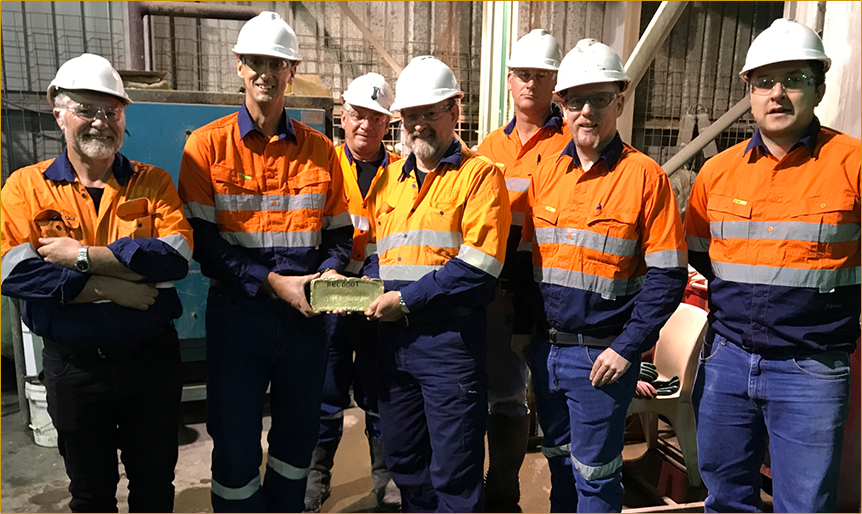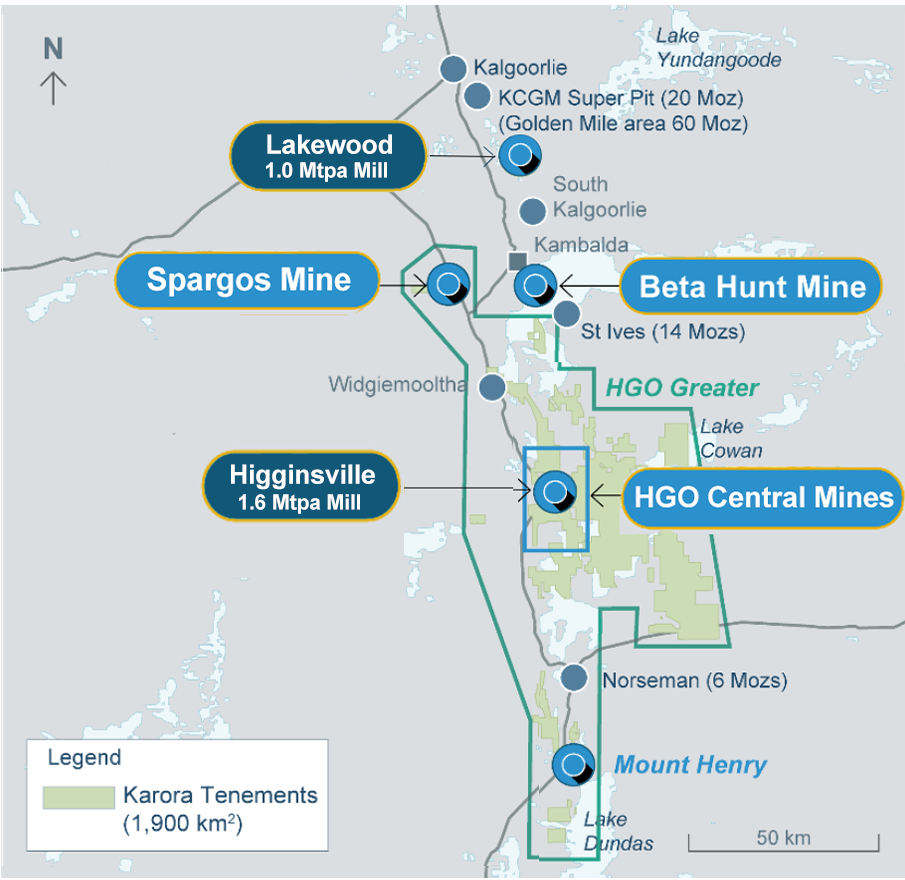
Karora’s primary gold producing operations are its 100% interests in the Beta Hunt Mine, the Higginsville Gold Operations (“HGO”) and Spargos Gold Mine, located in Western Australia approximately 60 kilometres from Kalgoorlie along the prolific Norseman-Wiluna Greenstone Belt.
Karora is targeting gold production of 170,000 - 185,000 ounces annually by 2024 through its self-funded organic growth plan. The growth capital required (outlined below) is carefully phased over a three-year period to allow for consistent free cash flow generation during the expansion.
2024 CONSOLIDATED GUIDANCE
| Production & Costs | 2024 | |||||||
| Gold Production | koz | 170 -185 | ||||||
| All-in sustaining costs1 | US$ / oz | 1,250 - 1,375 | ||||||
| Payable Nickel Production2 | Tonnes | 200 - 300 | ||||||
| Capital Investment | 2024 | ||||||
| Sustaining Capital | A$ (M) | 11 - 16 | |||||
| Growth Plan Capital | A$ (M) | 80 - 90 | |||||
| Exploration & Resource Development | A$ (M) | 18 - 23 | |||||
Notes to above Tables :
Karora acquired the HGO operations on June 10, 2019, which is comprised of a central 1.6 million tonnes per annum (“Mtpa”) gold treatment plant, a large historical resource inventory and a substantial portfolio of gold tenements, including open pit and underground mines. The treatment plant is fed by material from the Beta Hunt Mine and the Higginsville mining operations.
In July 2022, Karora acquired a second gold processing facility, the Lakewood Mill located near Kalgoorlie, Western Australia, approximately 60 kilometers from the Beta Hunt Mine. The addition of Lakewood increased Karora's nominal processing capacity to approximately 2.6 Mtpa (1.6 Mtpa at Higginsville and 1.0 Mtpa at Lakewood) and significantly de-risks our growth plan to increase gold production.
Karora continues to focus on enhancing the operational synergies between its operations as well as exploring additional opportunities in the region.

Gold - Consolidated Mineral Resources as at Sept 30, 2023
| Measured | Indicated | Measured & Indicated | Inferred | |||||||||
|---|---|---|---|---|---|---|---|---|---|---|---|---|
| Mineral Resource | Kt | g/t | Koz | Kt | g/t | Koz | Kt | g/t | Koz | Kt | g/t | Koz |
| Beta Hunt | 1,278 | 2.8 | 116 | 16,855 | 2.7 | 1,484 | 18,133 | 2.7 | 1,600 | 12,865 | 2.6 | 1,086 |
| Higginsville | 13,355 | 1.4 | 582 | 18,469 | 1.7 | 1,007 | 31,824 | 1.6 | 1,589 | 6,931 | 2.0 | 452 |
| Total | 14,633 | 1.5 | 698 | 35,324 | 2.2 | 2,490 | 49,957 | 2.0 | 3,189 | 19,796 | 2.4 | 1,538 |
Gold - Consolidated Mineral Reserves as at Sept 30, 2023
| Proven | Probable | Proven & Probable | |||||||
|---|---|---|---|---|---|---|---|---|---|
| Mineral Reserves | Kt | g/t | Koz | Kt | g/t | Koz | Kt | g/t | Koz |
| Beta Hunt | 316 | 2.7 | 28 | 6,260 | 2.7 | 545 | 6,577 | 2.7 | 573 |
| Higginsville | 8,078 | 1.3 | 342 | 6,196 | 1.8 | 363 | 14,273 | 1.5 | 705 |
| Total | 8,394 | 1.4 | 369 | 12,456 | 2.3 | 909 | 20,850 | 1.9 | 1,278 |
Detailed Footnotes relating to Mineral Resource Estimates as at September 30,2023
(1) Mineral Resources are not Mineral Reserves and do not have demonstrated economic viability. There is no certainty that all or any part of the Mineral Resources estimated will be converted into Mineral Reserves.
(2) The Measured and Indicated Mineral Resources are inclusive of those Mineral Resources modified to produce Mineral Reserves.
(3) The Mineral Resource estimates include Inferred Mineral Resources that are normally considered too speculative geologically to have economic considerations applied to them that would enable them to be categorized as Mineral Reserves. There is also no certainty that Inferred Mineral Resources will be converted to Measured and Indicated categories through further drilling, or into Mineral Reserves once economic considerations are applied.
(4) The Gold Mineral Resource is estimated using a long term gold price of US$1,700/oz with a US:AUD exchange rate of 0.70.
(5) The Gold Mineral Resource for Higginsville deposits is reported using a 0.5g/t Au cut-off for open pits (0.4g/t Au cut-off for Mt Henry Project) and a 1.3g/t Au cut-off grade for underground (1.6g/t Au for Spargos underground). The Gold Mineral Resource for Beta Hunt underground is reported using a 1.4g/t Au cut-off.
(6) The Nickel Mineral Resource is reported within proximity to underground development and nominal 1% Ni lower cut-off grade for the nickel sulphide mineralization.
(7) The Mineral Resource is depleted for all mining to September 30, 2023
(8) The Nickel Mineral Resource assumes an underground mining scenario and a high level of selectivity.
(9) To best represent "reasonable prospects of eventual economic extraction" the mineral resource for open pits has been reported within optimized pit shells at A$2,429 (US$1,700) and, for underground resources, areas considered sterilized by historical mining are depleted from the Mineral Resource.
(10) Mineral Resource tonnage and contained metal have been rounded to reflect the accuracy of the estimate, and numbers may not add due to rounding.
Detailed Footnotes relating to Mineral Reserve Estimates as at September 30, 2023
(1) The Mineral Reserve is estimated using a long-term gold price of US$1,500/oz and a long term nickel price of US$17,500/t with a US:AUD exchange rate of 0.70.
(2) At Beta Hunt, Underground Gold Mineral Reserves are reported at a 1.8 g/t cut-off grade while Nickel Mineral Reserves are reported at a 2% cut-off grade. At Higginsville, Underground Mineral Reserves cut-off grades vary between 1.6g/t to 2.0g/t. The cut-off grade considers Operating Mining, Processing/Haulage and G&A costs, excluding capital.
(3) At Higginsville, Open Pit cut-off grades vary between 0.8 g/t to 1.0g/t. The cut-off grade considers dilution, mine recovery, mining and processing/haulage costs. Dilution and recovery
Straight from our desk, to your inbox.
Subscribe To Our News Releases
© All rights reserved Karora Resources 2024